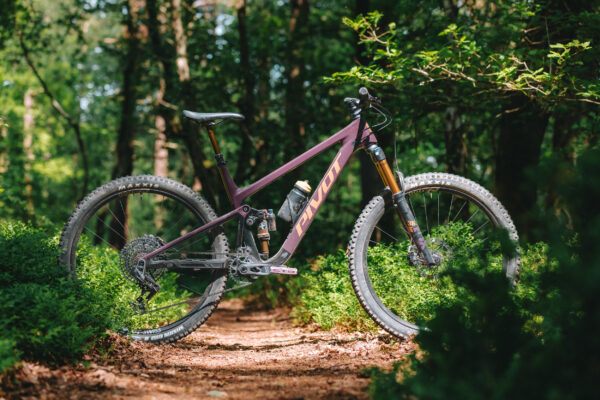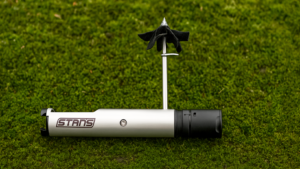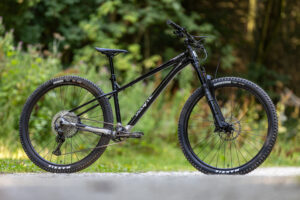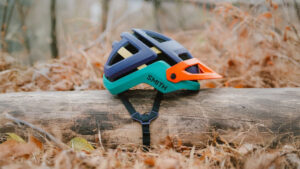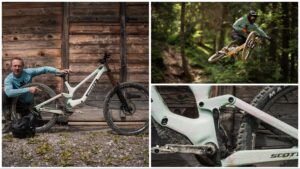The Trailcat has us split down the middle, some of us at mbr loved its composure and support right out of the box, but I never gelled with its overdamped feel
Marmite on wheels: the Pivot Trailcat LT is either a short travel enduro shredder, or an overdamped and overbuilt trail bike, depending on which of us you chat to
Pivot’s Trailcat comes in two formats, the 140 / 120mm travel SL and the 150 / 135mm travel LT here. Both share the same relatively light, ultra high quality frame but are separated by different linkages, shocks and shock positions.
Gorgeously packaged looks and premium quality control come at a high price though. I’m not alone in struggling with the default shock tune either and many of Pivot’s signature features have significant cons too.
– Short of time? Click here to skip to the verdict –

Ramping through the travel on the Trailcat – the fork is supple enough to dial on low speed compression and keep the front up
Pivot Trailcat LT need to know
- Longer Travel version of Trailcat trail bike, with 135mm of DW Link suspension
- HollowCore carbon frame with 29er wheels and mullet potential thanks to a flip chip
- Tool Shed internal storage, chainstay protection and new internal cable routing
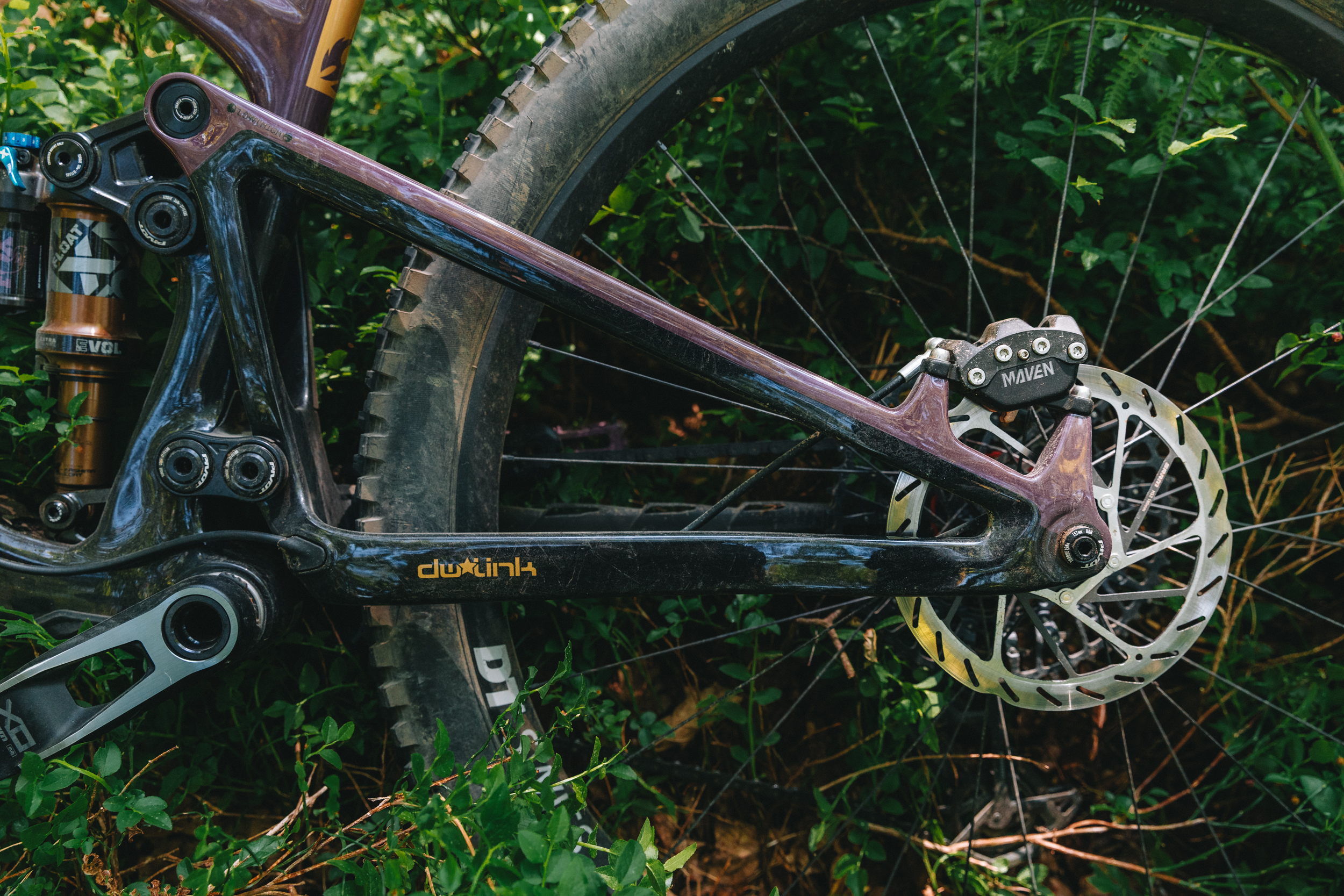
The one-piece back end is super stiff, and the alignment perfect, which makes for a really supple suspension feel
Frame and geometry
Pivot’s Trailcats slide in between the brand’s 429 and Switchblade bikes with a mid travel competitive frameset weight of just under 3kg, despite the extra mass of the piggyback Float X shock.
A recent move to lifetime frame warranty supports Pivot’s excellent reputation for high quality construction too, with every frame checked pre-build rather than a percentage sample. Alignments are excellent and the big pivots and forged linkages move like silk with the shock removed. And Pivot it’s also confident enough in its QC to stick with a Press Fit rather than screw in bottom bracket.

The storage door is pathetically small, making it for rarely used items only
The new Tool Shed internal storage in the downtube only adds 50g to the frame weight and the locking lever, padded back and magnetic chain link in the lid are really neatly done as well.
While the brake hose and cable are free range within the frame they’re securely clamped at each end. You can also run them either side of the head tube depending on your braking preference and noise is further muted by extensive rubber chain slap protection on the swingarm.
To keep 2.6in of rear tyre clearance in a relatively short (433mm), very stiff rear end, Pivot is one of the few brands still persevering with Super Boost 157mm rear hub spacing. While I respect its stubborn engineering stance, it undoubtedly makes sourcing replacement or spare rear wheels and hubs much harder.
My sample also developed a BB creak during testing, which anecdotal evidence suggests isn’t rare. Oh and the slim down tube means the Tool Shed aperture is awkwardly narrow and even getting a super light, low volume TPU tube in or out is a real fight.

With a relatively high BB even in the low setting, the geo flip chip will really only be used when mulletting the bike
The eccentric geometry chip was also so tight on my sample I couldn’t physically budge it for fear of damaging the bolt, which meant I couldn’t try the high geo setting and its 6mm lift. But with a BB drop of 34mm and too high 339mm static height you’ll likely only want to use that if you’re slotting in a mullet rear wheel.
Otherwise the 65.3° head angle and 474mm reach on the large are a happy average for this category of bike. It’s worth noting the forward foot of the seat tube means that the 75.6° quoted effective seat angle was actually 74.8° at my saddle height of 745mm.

A Fox Float X 55mm-stroke trunnion shock lent the back end a super supple feel… once the spacer was removed
Components
While the frame is loaded with deliberately different features, the specification is mostly very well proven kit. A Fox Factory 36 (not the latest one) fork with the Grip X2 damper, a Float X 55mm-stroke trunnion shock and Transfer dropper post are obvious highlights.
The collar and cuff Kashima gold carries over in the logos and coachwork of the Doctor Purple colour way here, or you can pick the gilt free Green Meadow Mist (their capitals not ours grammar fans).

Pivots own carbon bar has a great shape, but the accompanying stem was way too long and lent the bike a vague feel
You get Pivot’s own carbon bar too, but otherwise the DT Swiss XM1700 wheels, SRAM X0 AXS Transmission, Maven silver brakes and steel railed WTB saddle are decidedly mid range considering the near five figure price tag.
This spec is near the bottom of the 14 model US range too, which spans $6899 – $13499. But you can choose premium SRAM XX or Shimano XTR as well as Reynolds carbon wheels and Fox Live Valve Neo shocks to your toppings list if you want. Whatever spec you go for check stem length though as our bike came with a 55mm Pivot piece, not the listed 45mm.

Balancing the bike took some time, largely because the shock was harder to set up than the fork
Performance
Even with the stem sorted, the Trailcat took a while for me to balance and that was largely due to the suspension. Running the fork pressure much lower than recommended is always my first move with a Grip X2 damper. But once I’d done that the 36 felt great in a controlled rather than comfortable way.
The rear shock proved a tougher nut to crack as it felt both over active when pedalling but constipated on bigger compressions. Adding low speed compression helped stabilise my seated efforts but clicking on enough support to calm things out of the saddle killed fluid traction on tech sections.

Ditching the big 0.4cu in volume spacer helped the Pivot felt noticeably more liberated
Opening the EVOL air can revealed a big 0.4cu in volume spacer though so I ditched that and the Pivot felt noticeably more liberated straight away. Switching to a lighter tuned shock was when the Trailcat LT came properly alive though. Making the full use of those silky bearings and sweet alignment to feel like a spring lamb rather than a sodden sheep. It also meant I could finally bring the rebound adjust back into the working range rather than being caught between the syrup slow penultimate click and recoil-happy full open.

JD was more taken with the Trailcat than I was, despite binning it at Bikepark Wales
At this point I should point out that Jamie here at mbr rode the bike and really liked it in stock form, with compression dialled on to give the bike composure on descents. It’s a view shared with other testers I’ve spoken to as well.
I had a detailed conversation with Pivot CEO Chris Cocalis (the fact he replied himself is a big tick in my book alone) about their decision to go with a more supportive mid level tune too. He also explained that while the shock and shock tune are shared with the longer travel Switchblade trail bike and Shuttle AM E-MTB they could have changed it if they’d wanted to.
I agree that if you want a really supportive feel for more groomed, high load bike park style trails the extra support will be welcome. Plus as you’d expect the lighter tune makes the Trailcat even more reliant on the ‘climb’ lockout lever when pedalling with power. However I’ve also talked with other testers who shared my view on it being over-damped and feeling significantly better without the volume spacer.

There’s a ton of grip when climbing on this bike, but on long drags the seat post is too slack
I also took the opportunity to fit a light tuned Live Valve Neo shock set up I have on test. That was transformative in terms of combining the full fluid grip and playful responsiveness with efficient pedalling and was the point the Trailcat really started purring. However not only is the Neo version of this bike a $2,200 upcharge (still with alloy wheels) but it comes with a medium rather than light damping tune.
Interestingly both Trailcat versions come with an EXO+ DHRII rear tyre. This is definitely reassuring when things get rocky and underlines the ‘hard core’ vibe of the Pivot. At over 1,150g with a slow, growly roll it’s a real anchor when accelerating, climbing or rolling and the LT felt much livelier when I switched to Rekon Race rubber out back.
The over-damped rear shock combined with the very stiff Superboost rear end and short linkages meant neither shock gripped as I’d expect either. Especially when I wound on low speed compression to stifle the pedalling bob or pulled the super powerful Maven rear brake.
Then again, when you do get the suspension sorted – or Neo intervenes – that short, stiff rear end and the broad press fit bottom bracket kick really hard. And while it feels dislocated at first, the contrast between very rigid hindquarters and more fluid, flowing main frame makes the fork and front tyre feel really connected on random off piste enduro race tracks.

The Trailcat LT is stranded in travel no-man’s land, without enough travel to be a burly trial bike, and too much for a downcountry whippet
Verdict
You’ve only got to look at how different people react to various generations of Fox and RockShox forks to see that suspension feel can be a very personal thing. I really respect that Chris and Pivot are ‘owning’ their decisions in terms of the Trailcat in terms of DW Link dynamics, shock tune, SuperBoost and PF BB too. And let’s be straight here, if Jamie our Op Ed had written this review it would have been a lot more positive and you’ll find other tests online that have given the Trailcat LT a really enthusiastic stroke. The mid travel, mid weight bike segment has always been a minefield of choices in terms of suspension and tyre choice which have a big effect on complete package weight and performance. And again, what I would choose might be not what you’d pick for your riding, but aiming a 135mm travel bike at the harder hitting market already very well served by the longer travel Switchblade seems an odd move. There are some undeniable practical issues here too. The Trailcat is very pricey for the kit you get, press fit BB and SuperBoost have downsides that are more practically obvious long term than the claimed performance upsides, and the internal storage is awkwardly narrow. Initial price comparisons don’t play out in their favour either, even if long term reliability (apart from creaking) is reputedly excellent.




